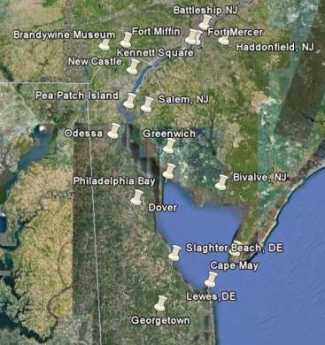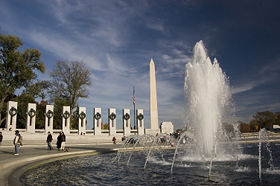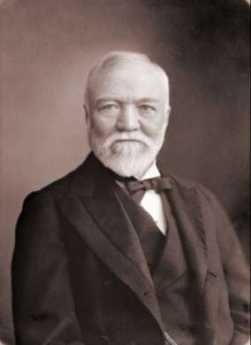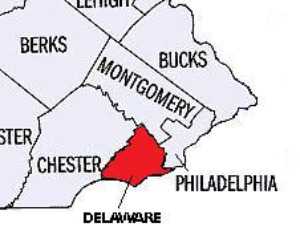Related Topics
Art in Philadelphia
The history of art, particularly painting and sculpture, has been a long and distinguished one. If you add in the art schools, the Philadelphia national influence on artists has been a dominant one.
Right Angle Club 2007
A report, to the year 2007 shareholders of the Right Angle Club of Philadelphia, by the outgoing president.
Land Tour Around Delaware Bay
 Start in Philadelphia, take two days to tour around Delaware Bay. Down the New Jersey side to Cape May, ferry over to Lewes, tour up to Dover and New Castle, visit Winterthur, Longwood Gardens, Brandywine Battlefield and art museum, then back to Philadelphia. Try it!
Start in Philadelphia, take two days to tour around Delaware Bay. Down the New Jersey side to Cape May, ferry over to Lewes, tour up to Dover and New Castle, visit Winterthur, Longwood Gardens, Brandywine Battlefield and art museum, then back to Philadelphia. Try it!
Laran Bronze

|
| World War II Memorial |
Bronze is the term for alloys of copper, most often mixed with tin, aluminum or whatever in varying proportions. Although the Bronze Age was one of the earliest stages of civilization, most of us would still have a hard time even stating the proper mixture of metals we might need to manufacture some bronze object for some particular purpose. No doubt Alexander the Great and his friends just stumbled on a mixture suitable for swords, helmets, and shields, but nowadays we expect a little more precision than that. So, go visit the engineers and artisans who occupy a whole block of downtown Chester and discover where the engineers take over from the sculptors. For example, the bronzes of the World War II Memorial in Washington were fabricated here, eventually bringing the final bill for the Memorial to $197 million. Whatever Laran may be, it isn't cheap.

|
| Andrew Carnegie |
Because of the size and weight of monumental bronzes, there is a tendency for bronze fabricators to be chosen in the general neighborhood of the permanent site of the statue. Even so, most large pieces are cast in smaller pieces and welded together at the site. Because that leads to more external struts that have to be trimmed and smoothed out, and more welding, there is a constant struggle to improve the technology to eliminate chop-ups. However, the bigger the piece, the harder it is to support with internal steel struts, so there is a constant process of re-engineering which is considerably under-appreciated. Since Larry Welker the proprietor of this operation went to Carnegie-Mellon, it brings up an analogous situation in steel fabrication. Andy Carnegie is mostly remembered for giving away libraries and mistreating his employees, but in fact, his achievement was an engineering one. His steel mills were four times as productive and efficient as his nearest competitor (Krupp of Germany). That not only made him the richest man in the world, it also made it possible for America to defeat Germany in World War I, and eventually become the dominant superpower.
Since sculptors are in a position to designate the bronze fabricator of their work, it would be wise for the fabricator to be nice to sculptors. However, computers have stuck their nose in this business, as they have in most businesses. A sculptor ordinarily makes a small model whose image is scanned into a computer and then blown up to final size. From this, a positive mold is made, from that a negative mold, and from that, the final positive bronze shell is cast. But once you pass that image through a computer you open up the possibility of synthetic images made through the mechanisms that make animated movies; and maybe eliminate the need for the sculptor entirely. That prospect naturally displeases sculptors, as does the potential for counterfeiting and exporting jobs.
Just about everything about bronze sculpture revolves around its massive weight. That's why bronze statues are typically hollow but carried too far, the statue can't support its own weight and must have internal steel struts. The internal struts are mainly stainless steel, often encased in the plastic sheathing. The molds which make these eggshells are generally made of ceramic, which is melted sand. The process starts with wax coatings, often a quarter-inch thick dipped in fine sand, then a layer of coarse sand finally baked into ceramic. That's the negative mold; the positive mold from which it is made starts with wax, covered by latex, covered by plaster of Paris. Since a lot of steps don't come out perfectly, they have to be repeated. All in all, it becomes convincing that spending $197 million for a war memorial is entirely legitimate, because we haven't even described the costs for the artist at one end of the process, and the appalling transportation issues at the final step.
Although the WWII Memorial isn't even in Philadelphia, it's surely worth a trip to Washington to see what Philadelphia can do. While you are there, look for the "Easter Eggs". That's the term for humorous images hidden by the artist within the serious larger object. This too is a tradition going back to ancient times; in the case of the War Memorial, the artist hid images of at least one soldier "goofing off" in each freeze. Perhaps even that could be done by computer, but it's harder.
WWW.Philadelphia-Reflections.com/blog/1291.htm
Originally published: Monday, August 27, 2007; most-recently modified: Wednesday, May 22, 2019
